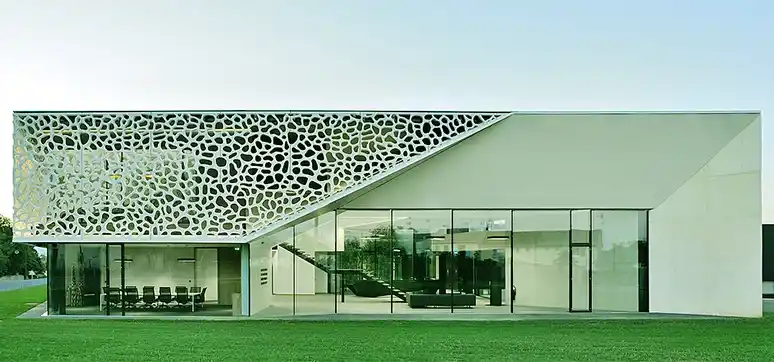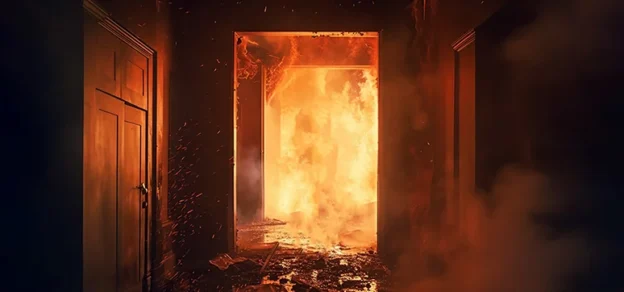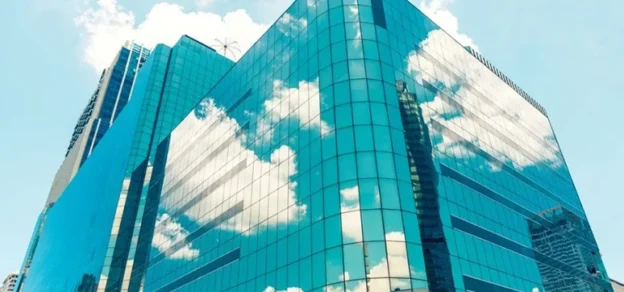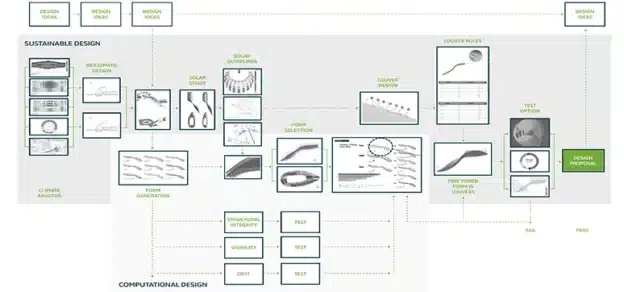A façade is the most striking elevational feature of a building. A good play of volume, scale, light, and shadow constitutes an impressionable façade design. The façade is an architectural element that enhances the visual aesthetics and indoor environment of the structure. With the advancements in science and technology, modern-day architects have been experimental with façade designing. New materials and computational software have made it easier to explore new façade design concepts.
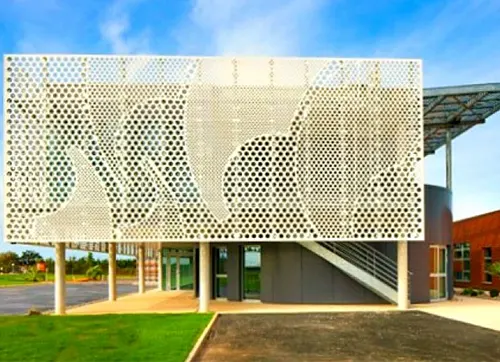
Glass-cladding façades have been a long-standing choice for elevating building elevations. However, the suitability of glass in the tropical weather of India has been questioned because of its heat-absorbing and light-reflective properties. The excessive use of glass in façade designs created the urban heat island effect. A glass façade traps and reflects heat thereby impacting the micro-climate and increasing local temperatures. Hence, glass façade buildings consume more energy to support ventilation and cooling thus increasing their functional costs.
However, there are promising alternative solutions to glass façades that are now taking over the industry. These include parametric, vegetated, and perforated façades which have a sustainable and tech-integrated approach to their design. While the central idea of a façade is to make the building stand out, it should also improve the functional productivity of the building based on its purpose and location. Hence, these alternative façade ideas are adopted with the intent of creating climate-responsive and contextual designs.
Applications of a Perforated Screen
Perforated screens find applicability in both indoor and outdoor spatial designs. Their ability to create privacy while maintaining visual connection makes them suitable for manifold purposes. In terms of exterior applications, perforated screens can be used as façades like an artsy blanket covering the building. Perforated façades provide the liberty to manipulate scales and volumes by playing with the opening sizes. The suitability of perforated façades cannot be compartmentalized for any building typology. A perforated façade can be designed for residential, institutional, commercial, hospitality, and healthcare buildings. The design flexibility of perforated façades provides them with the freedom to be customized according to the building’s use and purpose.
Perforated Façades
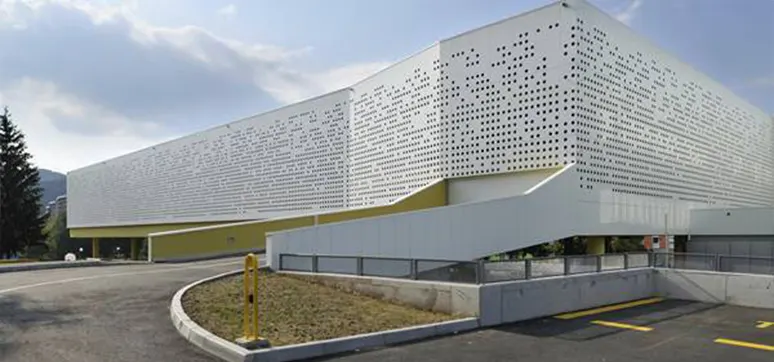
The Perforated or Jali façade has become a designer’s favourite because of its passive cooling benefits. In traditional Indian architecture, intricately carved wood and stone jali is a significant elevation element that is suitable for the country’s tropical climate. The use of jali screens can also be traced back to Mughal architectural influences in India.

The medieval-age buildings in Rajasthan and Delhi are excellent examples of intricately carved and latticed jali façades. The present-day jali façades are mostly linear and geometric in form. Louvred façades can also be considered as an extension of perforated façades because of the similarity in their functional mechanism. Metal and brick are widely used for the construction of jali façades today. A perforated façade provides a continuous design language to the building by wrapping or enveloping it completely. The installation of a perforated façade involves an uncomplicated process. The prefabricated or precast perforated screens can be installed directly to studs or an aluminium frame.
Mechanism of a Perforated Façade

A perforated façade helps in regulating the building’s ventilation and indoor temperatures. It controls the entry and movement of air throughout the building by allowing for strategically designed openings based on the principles of the Venturi effect. The air passes through perforations that have a funnel-like cross-section; the smaller one being the air inlet and the bigger one being the air outlet.
This mechanism assists in increasing the velocity of air through diffusion. The inlet and outlet are shaped variably to ensure that the air in the windward direction moves through the building towards the leeward direction. The appropriate angulation of openings also protects the building surface from getting drenched by rain.
Benefits of a Perforated Façade
Perforated Façades are versatile because they allow room for creativity. It is feasible to explore materials, colours, and patterns in perforated screens. With perforated façades, it is easier to blend the natural landscape around the site with the building.

One of the greatest advantages of a perforated façade is that it provides privacy along with transparency. The small perforations or openings make it possible to build connectivity outdoors while maintaining the required seclusion. A perforated screen creates the necessary visual barrier that makes the user feel secure and creates a resilient indoor environment.
Energy Efficiency is another upside of using perforated façades for a building. Since a perforated screen is a passive cooling design element the energy invested in providing mechanical ventilation can be saved. It improves the building’s performance by limiting exposure to the sun and thereby effectively bringing down the running costs. Perforated façades help in achieving design sustainability with energy optimization. Sustainable architecture elements such as vernacular architecture, recyclable and renewable materials, and passive cooling can all be incorporated through an energy-efficient façade design. Metal is a durable lightweight material predominantly used to create perforated façades.
It does not considerably increase the dead load of the building. Since metal is malleable, it can be shaped into any form to suit the design sensibilities of the architect. It is also recyclable which reduces the demand for new materials resources. Another elevational benefit of a perforated screen is that it can be backlit. The frame of the perforations can be enhanced during the night making the building stand out in a busy urban landscape.
Perforated façades find wide acceptance in India because of their suitability for the local climate and architectural comfort. The reference of traditional jali elements in Indian architecture makes perforated façades a familiar design element for Indian users at the grassroots level. The perforation design can be modified to suit the needs of urban as well as rural-built environments. With such large-scale applicability and acceptance, perforated façades have the potential to redefine façade design in India.
City Hospital, Gorakhpur

The City Hospital, Gorakhpur is nestled within a humble urban fabric. The city maintains its originality through vernacular architectural elements and cultural representation. Thus, the built environment of Gorakhpur appears to be in a transitional process from traditional to modern.
The design of City Hospital by Ingrain Architects and Urban Designers identifies these characteristics and builds from there. The design concept of the building was perceived with the intent of creating a landmark building that is contextual yet modern and economical. Built in 2017, the City Hospital, Gorakhpur is a 5-floor state-of-the-art multi-speciality hospital for cardiac and neurosciences. This 125-bed hospital spreads over an area of 55,000 square feet. It accommodates a 16-bed Intensive Care Unit (ICU), 8 OPD cabins, 3 Operation Theaters (OTs), a Cath Lab, a Cancer Diagnosis Unit, a pharmacy, and other allied administration facilities. A rooftop canteen has also been designed to provide an eating area for patient attendants and relatives.
The hospital is not centrally air-conditioned to create an energy-efficient design. It works on a semi-air conditioning module where only the medically sterile areas are mechanically ventilated. The other areas of the hospital are naturally ventilated through openable windows. They are provided with split AC units to be used as and when necessary. This is considered to have helped significantly bring down the running cost of the building.

Ingrain did not want the building to have a glass façade because that would make the building appear alien in Gorakhpur’s urban setting. To respect the local context and climate, the architects proposed a perforated façade with openable windows in the external wall. The hot and humid climate of Gorakhpur demands passive cooling for buildings to have comforting indoor environments. Hence, the hospital has a perforated façade that allows good air circulation through organized façade openings. The façade also provides necessary shading by creating a patterned entry for light.
Access to fresh air and diffused sunlight through the perforated screen is considered to be helpful in the healing process. For a developing city such as Gorakhpur, the building design is exemplary for budget planning and execution. The employment of local workers and craftsmanship contributed to the design motto of achieving simplicity with modernity.
The modern perforated façade has been designed in square geometry. The square openings on the façade are placed in varying sizes to create an interesting pattern of design. The arrangement of the openings is such that it creates an illusion of more floors than there exist in reality. This provides an element of surprise making the building an architectural attraction of the city. The façade panels are prefabricated micro stainless steel jali and aluminium composite panels with MS framing.
The architecture of the hospital building significantly contributes to its exclusiveness. This unique façade design shuns the traditional notion that hospital buildings are designed with monotony. Instead, planning such façades helps enhance the functioning of the hospital by contributing to energy efficiency and optimization. This hospital design is a milestone project for the city of Gorakhpur which can encourage future buildings in the area to adopt a contextual design with a modern expression.
